Summary:
- UnitedHealth reports Q4 results on January 13th.
- The company has established a run of beating expectations.
- The shares are down 7.6% so far in January.
- The Wall Street consensus rating is a buy and the consensus price target implies solid return potential for 2023.
- The market-implied outlook (calculated using options prices) continues to be bullish.
jetcityimage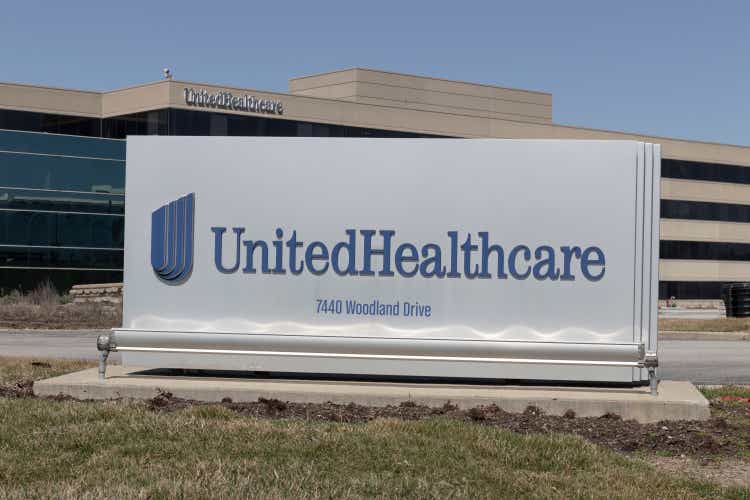
UnitedHealth (NYSE:UNH) reports Q4 2022 results before the market opens on January the 13th. UNH shares are down 7.6% so far in 2023, with a trailing 1-year total return of 5.7%. The healthcare plan industry, as tracked by Morningstar, has returned 7.2% over the past year. Over the past 3 years, UNH’s total return is 20.2% per year, almost 5% per year greater than the healthcare plan industry and more than 12% per year above the return of the S&P 500 (SPY).
Seeking Alpha
12-Month price history and basic statistics for UNH (Source: Seeking Alpha)
In 2022, UNH has benefitted from investors favoring healthcare for the sector’s defensive properties. The Health Care Sector SPDR (XLV), a portfolio of the healthcare stocks in the S&P 500, has returned 2.0% over the past year, as compared to -15.7% for the S&P 500 (SPY). UNH has a beta of 0.68 and XLV has a beta of 0.65 over the 3 years through November of 2022 (the latest data available on Portfolio Visualizer). These low betas are the hallmarks of defensive stocks.
UNH has forward and TTM P/E of 22.2 and 23.0, respectively. These P/E values are on the high end of the historical range over the past decade. As UNH has evolved to combine health insurance (UnitedHealthcare), data analytics (OptumInsight), pharmacy services (Optum Rx), and medical care facilities (Optum Health), it is not self-evident that the current valuation is problematic, however.
UNH has beaten earnings expectations in every quarter over the last 4 years and EPS has been higher in 2022 than in 2021 for Q1, Q2, and Q3 and this is expected to be the case for Q4. The consensus estimate for EPS growth over the next 3 to 5 years is 14.2% per year. The high outlier for EPS in Q2 of 2020 was due to insurance customers deferring care because of the COVID pandemic, resulting in a very low percentage of premiums paid out to cover claims, the medical loss ratio.
ETrade
Trailing (4 years) and estimated future quarterly EPS for UNH. Green values are amounts by which EPS beat the consensus expected value (Source: ETrade)
I last wrote about UNH on September 19, 2022, about 3 ½ months ago, at which time I maintained a buy rating. I have had a buy rating on UNH since February of 2021. At the time of my September 2022 analysis, UNH had reported strong earnings for Q1 and Q2 and the forward P/E was 23.9. The Wall Street consensus rating was a buy and the consensus 12-month price target corresponded to a total return of 12.9% over the next year. The market-implied outlook, a probabilistic price forecast that represents the consensus view from the options market, was bullish to the start and middle of 2023, with expected volatility of 28% (annualized). As a rule of thumb for a buy rating, I want to see an expected total annual return that is at least ½ the expected volatility. Taking the Wall Street consensus price target at face value, UNH fell slightly below this threshold (12.9% return vs. 28% volatility). The bullishness of the market-implied outlook was sufficient to convince me to maintain my buy rating. In the (roughly) 3 ½ months since my post, UNH has underperformed the S&P 500.
Seeking Alpha
Previous post on UNH and subsequent performance vs. the S&P 500 (Source: Seeking Alpha)
For readers who are unfamiliar with the market-implied outlook, a brief explanation is needed. The price of an option on a stock reflects the market’s consensus estimate of the probability that the stock price will rise above (call option) or fall below (put option) a specific level (the option strike price) between now and when the option expires. By analyzing the prices of call and put options at a range of strike prices, all with the same expiration date, it is possible to calculate the probable price forecast that reconciles the options prices. This is the market-implied outlook. For a deeper discussion than is provided here and in the previous link, I recommend this outstanding monograph published by the CFA Institute.
I note that the market-implied outlook for the healthcare sector was bullish when I last analyzed XLV, at the start of March of 2022.
As we approach the earnings report for Q4 of 2022, I have calculated updated market-implied outlooks for UNH and compared these with the Wall Street consensus outlook in revisiting my rating.
Wall Street Consensus Outlook for UNH
Seeking Alpha calculates the Wall Street consensus outlook for UNH using ratings and price targets from 26 analysts who have published their views in the past 90 days. The consensus rating is a buy, as it has been for all of the past 3 years. The consensus 12-month price target is $584.04, 19.2% above the current share price, for an expected total return of 20.5% over the next year. For context, the trailing 3-, 5-, and 10-year annualized total returns for UNH are 20.2%, 17.6%, and 26.0% per year, respectively. The Wall Street consensus price target corresponds to a total return that is generally in line with the trailing returns over the past decade.
Seeking Alpha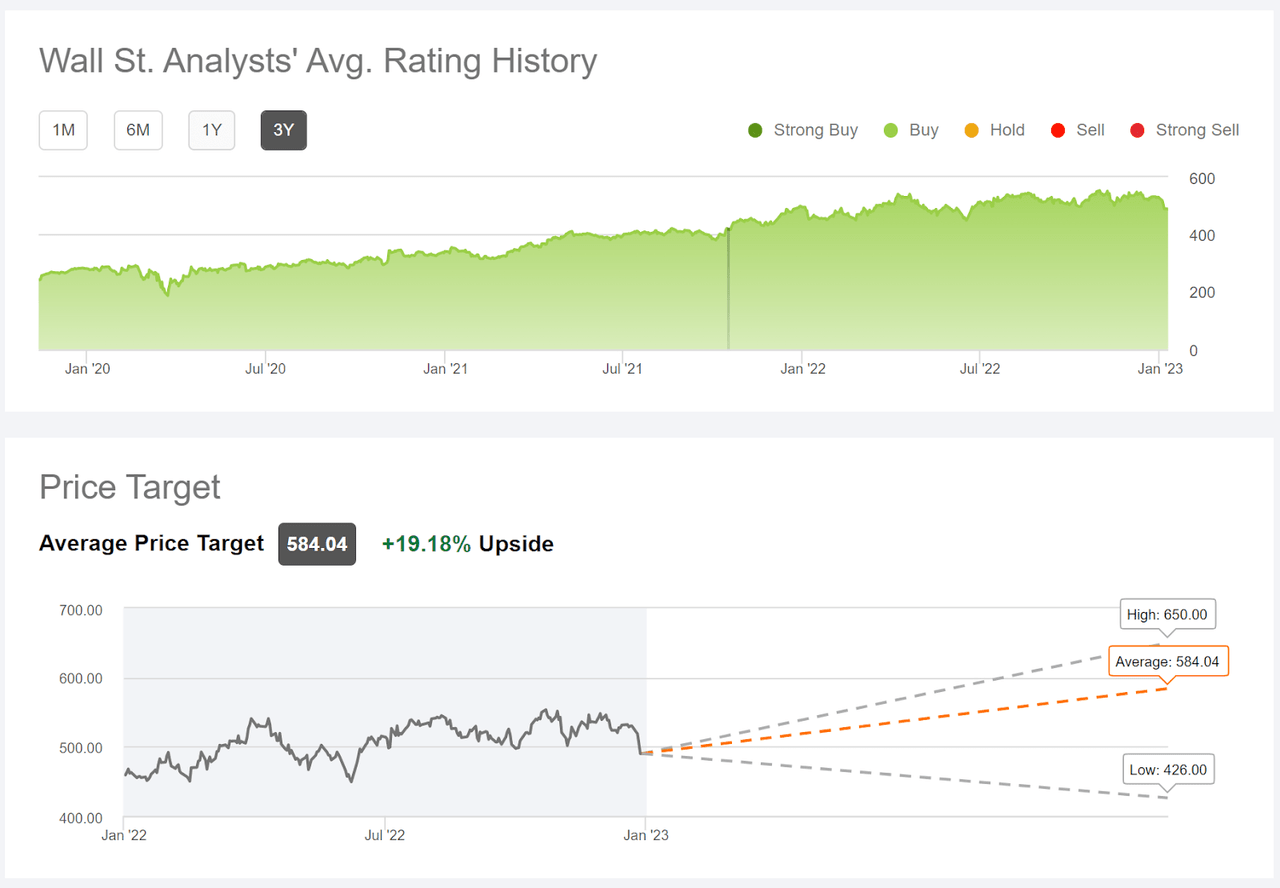
Wall Street analyst consensus rating and 12-month price target for UNH (Source: Seeking Alpha)
Of the 26 analysts in the cohort used to calculate the consensus, 14 assign a strong buy rating, 7 assign a buy, 3 assign a hold, and 2 give UNH a sell rating.
The 20.5% expected total return calculated using the consensus price target is markedly higher than the value in September (12.9%). The higher expected gains are due to the share price decline in recent months and the increase in the consensus price target.
Market-Implied Outlook for UNH
I have calculated the market-implied outlook for UNH for the 2.2-month period from now until March 17, 2023, for the 5.2-month period from now until June 16, 2023, and for the 12.3-month period from now until January 19, 2024, using the prices of call and put options that expire on these dates. I selected these expiration dates to provide a view well into Q1, to the middle of 2023 and through the entire year.
The standard presentation of the market-implied outlook is a probability distribution of price return, with probability on the vertical axis and return on the horizontal.
Geoff Considine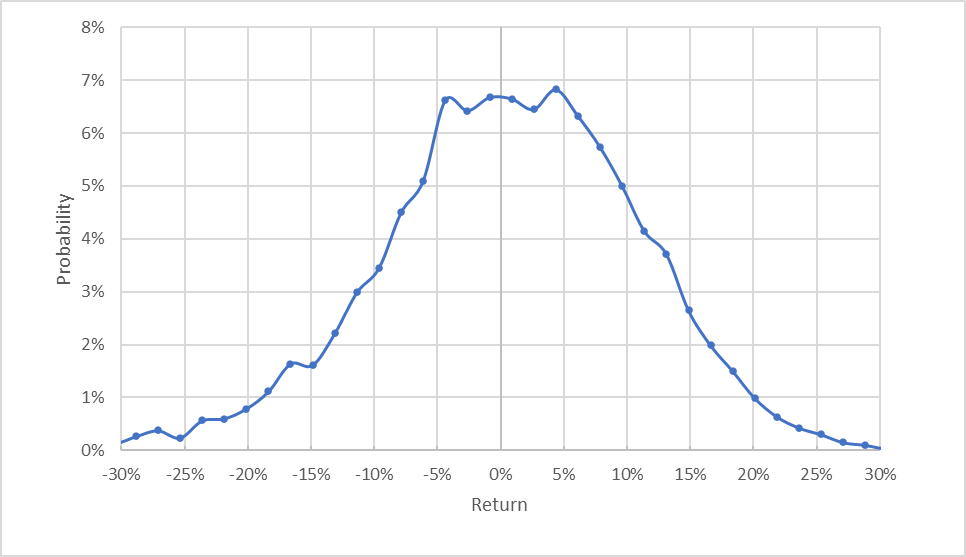
Market-implied price return probabilities for UNH for the 2.2-month period from now until March 17, 2023 (Source: Author’s calculations using options quotes from ETrade)
At first glance, the market-implied outlook for the next 2.2 months looks fairly symmetric, with comparable probabilities of positive and negative returns of the same size. The expected volatility calculated from this distribution is 25.4% (annualized). For comparison, ETrade calculates an implied volatility of 26% for the options with this expiration date.
To make it easier to compare the relative probabilities of positive and negative returns, I rotate the negative return side of the distribution about the vertical axis (see chart below).
Geoff Considine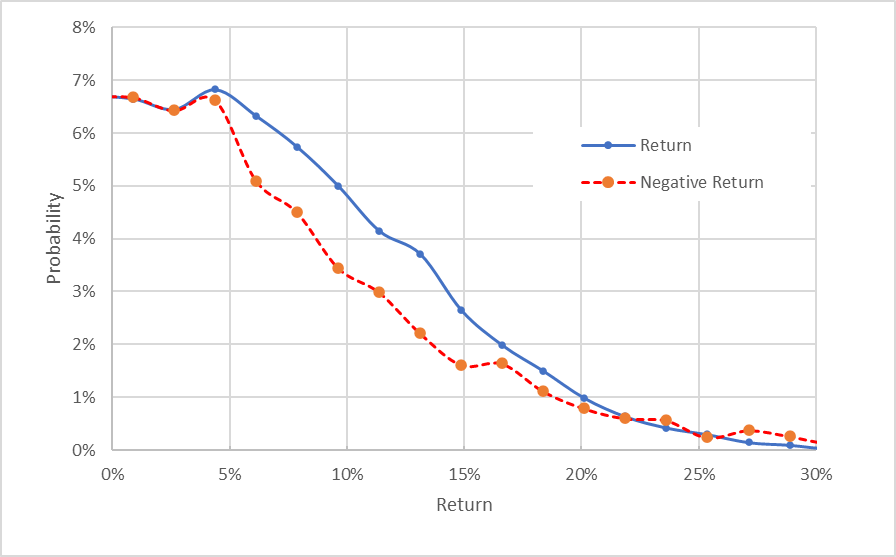
Market-implied price return probabilities for UNH for the 2.2-month period from now until March 17, 2023. The negative return side of the distribution has been rotated about the vertical axis (Source: Author’s calculations using options quotes from ETrade)
This view shows that the probabilities of positive returns are consistently higher than the probabilities of negative returns of the same size, across a wide range of the most-probable outcomes (the solid blue line is on or above the dashed red line over most of the left ⅔ of the chart above). This is a bullish orientation.
Theory indicates that the market-implied outlook is expected to have a negative bias because investors, in aggregate, are risk averse and thus tend to pay more than fair value for downside protection. There is no way to measure the magnitude of this bias, or whether it is even present, however. The expectation of a negative bias reinforces the bullish interpretation of this outlook.
The market-implied outlook for UNH for the 5.2-month period to June 16th is similarly bullish to the shorter-term view. The expected volatility calculated from this outlook is 26.6% (annualized).
Geoff Considine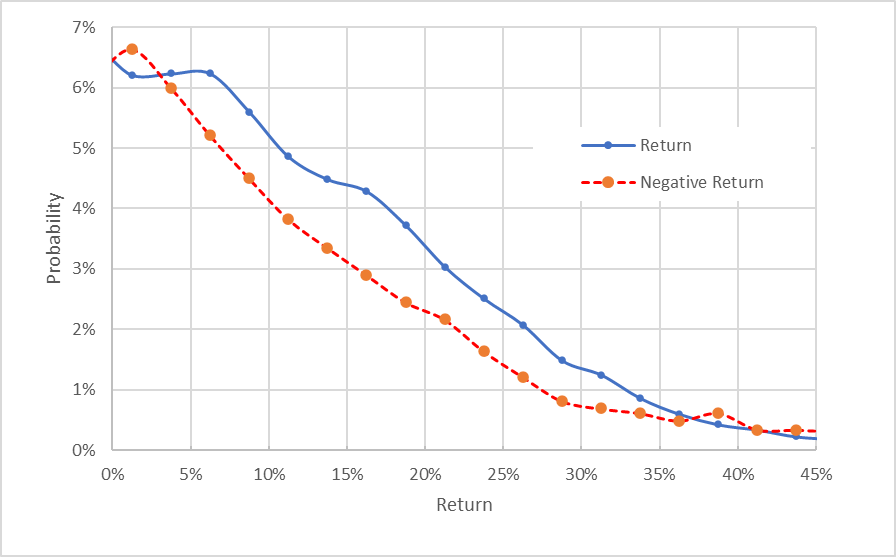
Market-implied price return probabilities for UNH for the 5.2-month period from now until June 16, 2023. The negative return side of the distribution has been rotated about the vertical axis (Source: Author’s calculations using options quotes from ETrade)
The market-implied outlook for 2023 as a whole (calculated using the price of call and put options that expire on January 19, 2024) is also bullish, with expected volatility of 27% (annualized).
Geoff Considine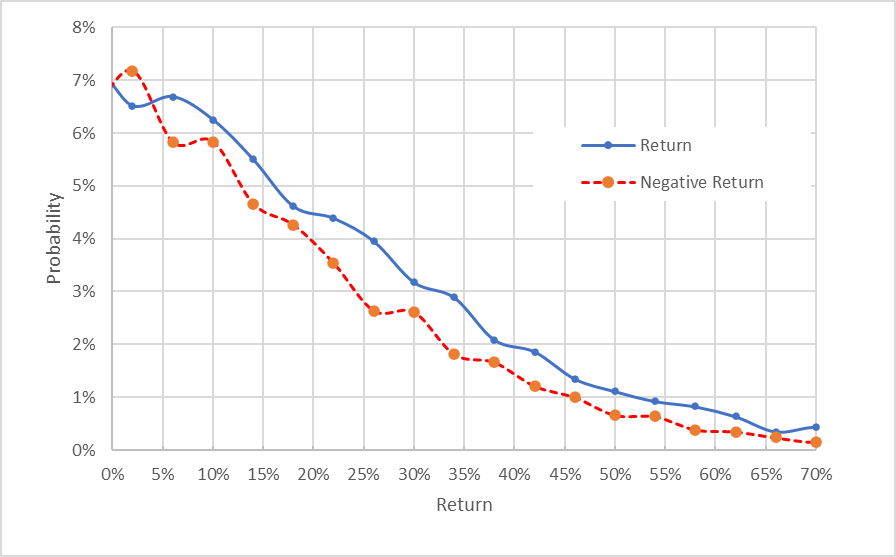
Market-implied price return probabilities for UNH for the 12.3-month period from now until January 19, 2024. The negative return side of the distribution has been rotated about the vertical axis (Source: Author’s calculations using options quotes from ETrade)
These three market-implied outlooks tell a consistent story for UNH, with a bullish orientation over the next 2.2, 5.2, and 12.3 months, and a slight upward trend in expected volatility over this period. The expected volatility has fallen slightly since my September analysis.
Summary
While UNH has fallen to start 2023, the trailing returns for periods of a year and beyond are impressive. UNH has delivered solid earnings in recent quarters, but the stock’s outperformance may be largely due to investors favoring the health insurance industry for its defensive properties. The valuation is on the high end of values over the past decade. The Wall Street consensus rating for UNH has been favorable for years and this confidence in the company has paid off. The consensus rating continues to be a buy and the consensus 12-month price target implies a total return of 20.5%. Taking the consensus price target at face value, this return is well above ½ the expected volatility (27% annualized for the next year), meeting my criterion for an attractive risk-return profile. The market-implied outlooks are bullish into Q1, to the middle of the year, and to the start of 2024. I am maintaining a buy rating on UNH.
Disclosure: I/we have no stock, option or similar derivative position in any of the companies mentioned, and no plans to initiate any such positions within the next 72 hours. I wrote this article myself, and it expresses my own opinions. I am not receiving compensation for it (other than from Seeking Alpha). I have no business relationship with any company whose stock is mentioned in this article.
